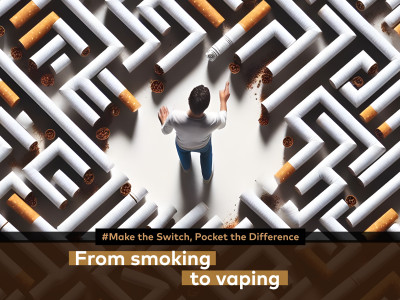The UKECRF is an initiative developed by Cancer Research UK in partnership with Public Health England and the UK Centre for Tobacco and Alcohol Studies. The UKECRF looks at new studies on electronic cigarettes and provides a critical overview of each of them. It brings together experts to discuss emerging evidence about e-cigarettes.
In “Changes in Use Patterns Over One Year Among Smokers and Dual Users of Combustible and electronic cigarettes”, the study’s authors concluded: “This longitudinal cohort study of smokers and dual users who were initially not interested in changing their use patterns shows that amongst dual users assessed at 1-year follow-up, slightly fewer than half had maintained their pattern of dual use; the majority of those who discontinued dual use transitioned to exclusive smoking. The data also show that over the course of one year, those who were dual users at baseline were more likely to have stopped smoking completely than were those who were exclusive smokers at baseline.”
UKECRF breaks down the research:
Study aims
This U.S. study analysed how patterns of product use varied between 117 exclusive smokers and 205 dual users over one year and examined predictors of continued dual use. Data on patterns of use were collected via in-person assessments at 4, 8 and 12 months from smokers and dual users who had no intention to quit smoking in the next 30 days. Abstinence from cigarettes was self-reported and 7-day abstinence was biochemically verified.
Key findings
At 1-year follow up, biochemically confirmed 7-day cigarette abstinence was significantly different (p=0.03) among baseline dual users (8.0%) from baseline smokers (1.9%). There was no significant difference (p=0.7) between these groups for self-reported 30-day abstinence.
After one year, less than half of baseline dual users were still dual users (n=100, 48.8%). 90 (43.9%) reported being exclusive smokers, 12 (5.9%) being exclusive vapers and 3 (1.4%) being abstinent from both products. Among baseline smokers, although there was some experimentation with e-cigarettes at intermediate follow up points, the majority (92.3%) returned to exclusive cigarette use.
Among those still smoking after one year, there was no significant difference between baseline dual users and baseline smokers in the mean change in number of cigarettes smoked between baseline and 1-year follow up.
In statistical modelling, baseline dual users were more likely to continue dual use if they were white, had lower cigarette dependency according to the Wisconsin Inventory of Smoking Dependence Motives (WISDM) and a higher e-cigarette dependence (e-WISDM).
Study Limitations
No adjustment was made for differences in baseline demographic variables between dual users and smokers, so confounding may have accounted for the differences in cessation outcomes. No causal associations between dual use and cessation outcome can be made.
Sub-group sample sizes were small which increases the uncertainty of estimates and meant it was not possible to model significant predictors of quitting smoking.
Participants had no interest in quitting and dual users may be people who have already failed in their quit attempts. This means that the participants may be more resistant to quitting, which may have impacted cessation outcomes.
Participants were recruited via television and social media only and only those who were not interested in cessation were recruited. The dropout rate at 1-year follow-up was high (23.7%). Therefore, the participants and results may not be generalisable to the wider vaping population.
Resources:
- “Changes in Use Patterns Over One Year Among Smokers and Dual Users of Combustible and electronic cigarettes” by Piper, Baker, Benowitz, and Jorenby - [link]
Dave Cross
Journalist at POTVDave is a freelance writer; with articles on music, motorbikes, football, pop-science, vaping and tobacco harm reduction in Sounds, Melody Maker, UBG, AWoL, Bike, When Saturday Comes, Vape News Magazine, and syndicated across the Johnston Press group. He was published in an anthology of “Greatest Football Writing”, but still believes this was a mistake. Dave contributes sketches to comedy shows and used to co-host a radio sketch show. He’s worked with numerous vape companies to develop content for their websites.
Join the discussion
Harm Reduction For The Rich
The United Kingdom risks becoming a harm reduction country only for the wealthy, according to Michael Landl of the World Vapers’ Alliance
CAPHRA Highlights Tobacco Control Flaws
The Coalition of Asia Pacific Tobacco Harm Reduction Advocates highlights the flaws in tobacco control which has led to the rise of black market in Australia
A Missed Opportunity at COP10
The Smoke Free Sweden movement says that COP10 was a missed opportunity to save millions of lives
COP10: Promote Tobacco Harm Reduction
Experts with Smoke Free Sweden are emphasising the urgent need for a Tobacco Harm Reduction approach at COP10












